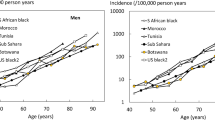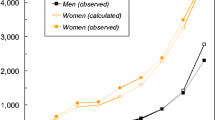Abstract
Summary
The incidence of hip fractures in Turkey increased markedly from that reported in 1988/1989 so that FRAX® models for Turkey should be revised.
Introduction
The MEDOS study in 1988/1989 reported that men and women from Turkey had exceptionally low rates of hip fracture. The aim of the FRACTURK study was to estimate current and future hip fracture risks and the prevalence of osteoporosis in Turkey.
Methods
Hip fracture cases in 2009 were identified from interviews of a population-based sample of 26,424 residents aged 50 years or more in 12 different regions of Turkey and in two hospital surveys. Bone mineral density was evaluated by DXA in an age-stratified sample of 1,965 men and women.
Results
Hip fracture incidence in the community-based survey was similar to that in the hospital survey. The age-specific incidence in men and women was substantially higher than that reported for 1988/1989. At the age of 50 years, the remaining lifetime probability of a hip fracture was 3.5% in men and 14.6% in women. In 2009, there were approximately 24,000 hip fractures estimated in Turkey, 73% of which were found in women. Assuming no change in the age- and sex-specific incidence, the number of hip fractures was expected to increase to nearly 64,000 in 2035. The prevalence of osteoporosis at the femoral neck was 7.5% and 33.3% in men and women, respectively, aged 50 years or more.
Conclusion
Although Turkey is still among the countries with low hip fracture rates in Europe, the incidence has increased markedly in the last 20 years. This finding can be used to recalibrate fracture risk assessment models for Turkey.

Similar content being viewed by others
References
World Health Organization (2007) Assessment of osteoporosis at the primary health care level. WHO, Geneva. (www.who.int/chp/topics/rheumatic/en/index.html). Accessed 15 December 2010
Kanis JA on behalf of the World Health Organization Scientific Group (2008) Assessment of osteoporosis at the primary health-care level. Technical Report. WHO Collaborating Centre, University of Sheffield, UK. http://www.shef.ac.uk/FRAX. Accessed 15 December 2010
Kanis JA, Johnell O, Oden A, Johansson H, McCloskey EV (2008) FRAX™ and the assessment of fracture probability in men and women from the UK. Osteoporos Int 19:385–397
Cummings SR, Melton LJ (2002) Epidemiology and outcomes of osteoporotic fractures. Lancet 359:1761–1767
Bacon WE, Maggi S, Looker A, Harris T, Nair CR, Giaconi J, Honkanen R, Ho SC, Peffers KA, Torring O, Gass R, Gonzalez N (1996) International comparison of hip fracture rates in 1988–89. Osteoporos Int 6:69–75
Johnell O, Gullberg B, Allander E, Kanis JA (1992) The apparent incidence of hip fracture in Europe: a study of national register sources. MEDOS Study Group. Osteoporos Int 2:298–302
Elffors I, Allander E, Kanis JA, Gullberg B, Johnell O, Dequeker J et al (1994) The variable incidence of hip fracture in Southern Europe: the MEDOS Study. Osteoporos Int 4:253–263
Schwartz AV, Kelsey JL, Maggi S et al (1999) International variation in the incidence of hip fractures: cross national project on osteoporosis for the World Health Organization programme for research on ageing. Osteoporos Int 9:242–253
Kanis JA, Johnell O, De Laet C, Jonsson B, Oden A, Ogelsby AK (2002) International variations in hip fracture probabilities: implications for risk assessment. J Bone Miner Res 17:1237–1244
Gullberg B, Johnell O, Kanis JA (1997) World-wide projections for hip fracture. Osteoporos Int 7:407–413
Cooper C, Cole Z, Holroyd C, Earl S, Harvey N, Dennison E (2011) Secular trends in the incidence of hip and other osteoporotic fractures. Osteoporos Int 22:1277–1288
Turkey National Statistical Office (2009) TUIK-Turkey. http://report.tuik.gov.tr/reports/rwservlet?adnksdb2=&report=turkiye_yasgr.RDF&p_yil=2009&p_dil=1&desformat=html&ENVID=adnksdb2Env. Accessed 06 September 2010
United Nations (2008) Population Division of the Department of Economic and Social Affairs of the United Nations Secretariat, World Population Prospects: The 2008 Revision. http://esa.un.org/unpp. Accessed January 08, 2011; 12:46:30 PM
Kanis JA, McCloskey EV, Johansson H, Oden A, Melton LJ, Khaltaev N (2008) A reference standard for the description of osteoporosis. Bone 42:467–475
Lu Y, Fuerst T, Hui S, Genant HK (2001) Standardization of bone mineral density at femoral neck, trochanter and Ward’s triangle. Osteoporos Int 12:438–444
Looker AC, Wahner HW, Dunn WL et al (1998) Updated data on proximal femur bone mineral levels of US adults. Osteoporos Int 8:468–486
Sanders KM, Nicholson GC, Ugoni AM, Seeman E, Pasco JA, Kotowicz MA (2002) Fracture rates lower in rural than urban communities: the Geelong Osteoporosis Study. J Epidemiol Community Health 56:466–470
Chevalley T, Herrmann FR, Delmi M, Stern R, Hoffmeyer P, Rapin CH, Rizzoli R (2002) (2002) Evaluation of the age-adjusted incidence of hip fractures between urban and rural areas: the difference is not related to the prevalence of institutions for the elderly. Osteoporos Int 13(2):113–118
Melton LI (1995) Epidemiology of fractures. In: Riggs BL, Melton LJ (eds) Osteoporosis: etiology, diagnosis, and management, 2nd edn. Lippincott-Raven, Philadelphia
Satman I, Yilmaz T, Sengül A et al (2002) Population-based study of diabetes and risk characteristics in Turkey: results of the Turkish diabetes epidemiology study (TURDEP). Diabetes Care 25:1551–1556
Satman I, Alagöl F, Ömer B et al (2011) Diyabet, Hipertansiyon, Obezite ve Endokrinolojik Hastalıklar Prevalans Çalışması-II. Society of Endocrinology and Metabolism of Turkey (http://www.turkendokrin.org). Accessed 5 April 2011
Ahlborg GH, Johnell O, Jarvinen TLN, Karlsson MK (2004) Prevalence of low bone mass in women: secular trends over 30 years. J Bone Miner Res 19(suppl 1):S49
Joakimsen R, Magnus J, Fonnebo V (1997) Physical activity and predisposition for hip fractures: a review. Osteoporos Int 7:503–513
Berard A, Bravo G, Gauthier P (1997) Meta-analysis of the effectiveness of physical activity for the prevention of bone loss in postmenopausal women. Osteoporos Int 7:331–337
Martyn CN, Cooper C (1999) Prediction of burden of hip fracture. Lancet 353:769–770
Kanis JA, Johnell O, Oden A, Jonsson B, De Laet C, Dawson A (2000) Risk of hip fracture according to the World Health Organization criteria for osteopenia and osteoporosis. Bone 27:585–590
Tuzun S, Akarirmak U, Uludag M, Tuzun F, Kullenberg R (2007) Is BMD sufficient to explain different fracture rates in Sweden and Turkey? J Clin Densitom 10:285–288
Clark P, Lavielle P, Franco-Marina F et al (2005) Incidence rates and life-time risk of hip fractures in Mexicans over50 years of age: a population-based study. Osteoporos Int 16:2025–2030
Czerwinski E, Kanis JA, Trybulec B, Johansson H, Borowy P, Osieleniec J (2009) The incidence and risk of hip fracture in Poland. Osteoporos Int 20:1363–1367
Acknowledgements
This study was funded and promoted by the Turkish Osteoporosis Society. We are also grateful to Sanofi–Aventis, Roche, Novartis and MSD for their financial support. We would like to thank to Mr. Erkan Pekerkan and Mrs. Emine Pekerkan from Analyst Medical Marketing Research Ltd. for their great work and kind support during the study.
Conflicts of interest
None.
Author information
Authors and Affiliations
Consortia
Corresponding author
Additional information
G. Akyuz, T. Arasil, F. Atalay, G. Dincer, B. Durmaz, Y. Kirazli, Y.G. Kutsal, S. Oncel, and O. Peker represent the Turkish Osteoporosis Society.
Rights and permissions
About this article
Cite this article
Tuzun, S., Eskiyurt, N., Akarirmak, U. et al. Incidence of hip fracture and prevalence of osteoporosis in Turkey: the FRACTURK study. Osteoporos Int 23, 949–955 (2012). https://doi.org/10.1007/s00198-011-1655-5
Received:
Accepted:
Published:
Issue Date:
DOI: https://doi.org/10.1007/s00198-011-1655-5




